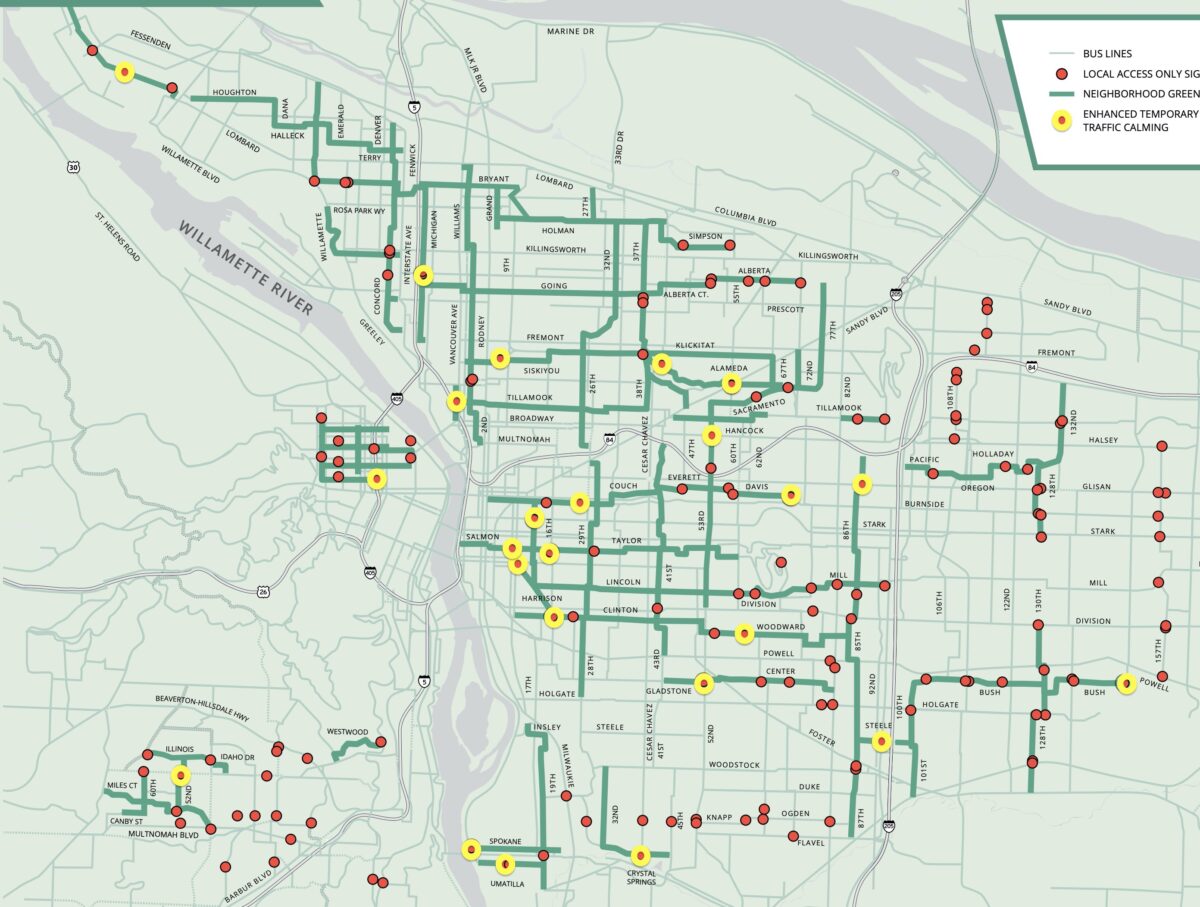
(Source: PBOT Neighborhood Greenways 2020 Status Report – edited slightly to add yellow circles for better visibility)
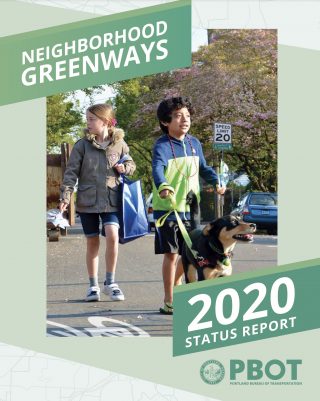
The City of Portland wants to take some of their Covid-inspired “slow streets” to the next level. And there are still too many drivers on streets where bicycle users are supposed to have priority. Those are two key “challenges” shared by the Portland Bureau of Transportation’s 2020 Neighborhood Greenway Status Report released Tuesday afternoon.
The new report follows up on PBOT’s 2015 Neighborhood Greenway Assessment Report, which was a more technical analysis of how greenways were performing in terms of traffic volume, safety, and speed. PBOT’s latest report is meant for a wider audience (11 pages versus 58 in the 2015 report) and offers an overview of neighborhood greenways in Portland two decades after city planners first began to create calm streets with the specific intention of reducing driver volumes and improving cycling conditions.
Advertisement

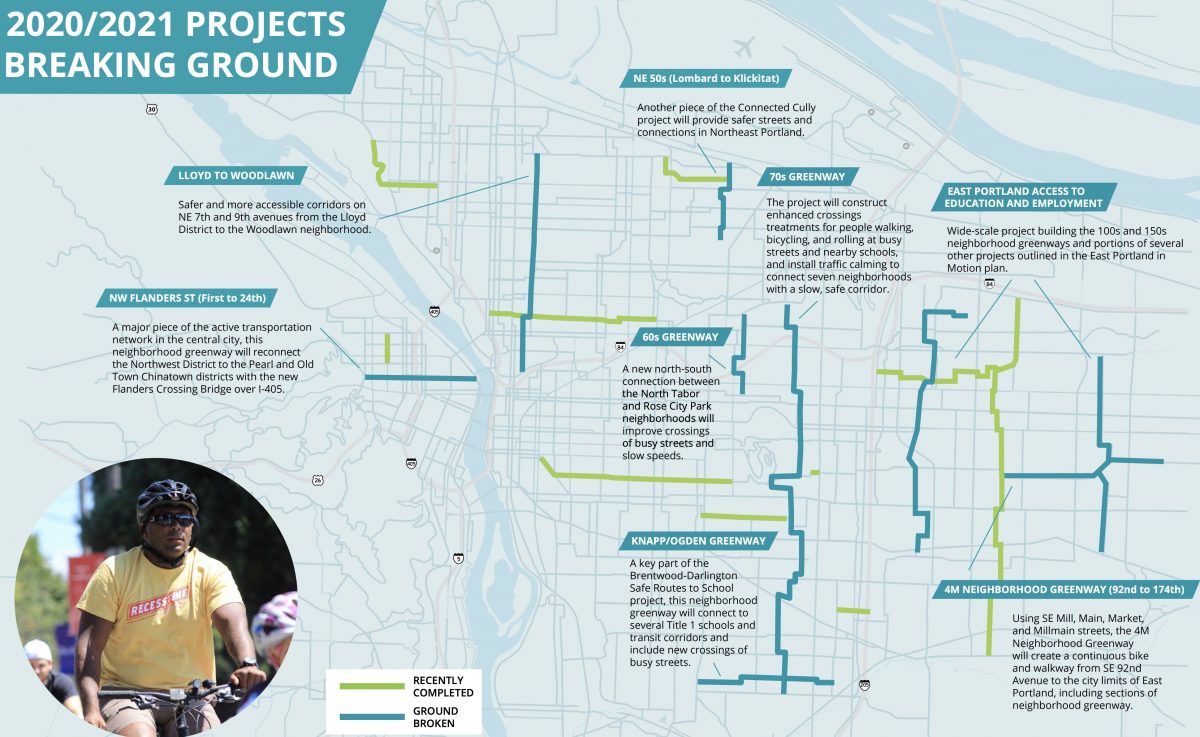
There are currently 103 miles of neighborhood greenways in Portland, the majority of which are in northwest, north/northeast and southeast neighborhoods. East Portland has long been trailing behind in greenway mileage but PBOT is working hard to reverse that narrative. The agency has 25 miles of greenways in east Portland either recently completed, under construction, or breaking ground soon.
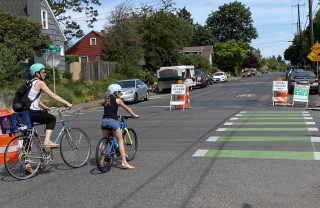
(Photo: Jonathan Maus/BikePortland)
The big takeaway in the report is that PBOT recommends 25 locations where they’d like to install temporary traffic calming. The idea is to expand on the “Slow Streets” program they launched at 100 locations back in May. “As traffic moves back to pre-Covid levels,” reads the report. “These temporary installations will slow or reduce traffic on neighborhood greenways where there were high levels of traffic before the public health crisis.” In addition, PBOT wants to create a “seasonal Slow Streets program” that would make the “local access only” concept more permanent. The report also recommends the creation of “neighborhood-wide slow zones with fewer cars driving through residential areas.” The report doesn’t explain these “slow zones” but PBOT has already created one in northwest by a combination of lowering speed limits and strategically making driving more difficult on certain streets.
In addition to these 25 traffic calming locations, PBOT recommends more diversion on greenways in general. Portland adopted a goal in 2015 to build neighborhood greenways to have less than 1,000 drivers per day. When that doesn’t happen they try to keep them below 2,000 drivers per day. The new report recommends a diversion plan (focused on equity of course) that will, “provide proactive support for neighborhood greenways so they meet the standards adopted by city council in 2015.”
PBOT first started building cycling-priority streets in the late 1980s in an effort to protect neighborhoods from drivers trying to avoid SE Division. Portland built 10 miles of “bike boulevards” (what we called them before PBOT changed the name in 2010) in the ten years between 1996 and 2006. Beginning in 2010 with the passage of the Bike Plan for 2030, greenways supplanted bike lanes to became the dominant bikeway built in Portland. We’ve built 73 miles of them since 2006.
— Jonathan Maus: (503) 706-8804, @jonathan_maus on Twitter and jonathan@bikeportland.org
— Get our headlines delivered to your inbox.
— Support this independent community media outlet with a one-time contribution or monthly subscription.




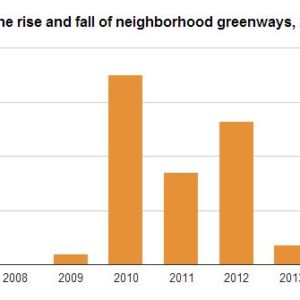


Thanks for reading.
BikePortland has served this community with independent community journalism since 2005. We rely on subscriptions from readers like you to survive. Your financial support is vital in keeping this valuable resource alive and well.
Please subscribe today to strengthen and expand our work.
Oh gee, even more investment for the inner Eastside while the remainder of the city gets almost nothing. Again, Eudaly’s PBOT showing that they truly don’t care about equity at all.
I agree that nopo looks neglected but at least the development goes well past 205.
I see one upgraded diverter east of I-205, two west of the river, and one in North Portland. The other 21 are in the inner Eastside.
Cully and Brentwood-Darlington are, yes, technically east of 205, but I think you’re just trolling if you think either are demographically or socioeconomically similar to the neighborhoods commonly understood as “inner eastside”
There are plenty of pockets of low income folks in the inner-eastside, and we shouldn’t erase them by talking about neighborhood averages.
There are also pockets of very rich folks in East Portland in parts of Hazelwood, Russel, Wilkes, Pleasant Valley, and Argay.
Thanks for your YIMBY opinion but there isn’t any “temporary enhanced traffic calming” in Cully or Brentwood-Darlington on PBOT’s map.
There are, however, ten such upgraded diverters in Portland’s wealthiest inner SE neighborhoods.
The dividing line is 82nd, not I-205. There’s a couple more between 82nd and I-205 on that map.
I guess traffic diversion is a perk only available to those living in neighborhoods where starter homes cost more than half a million dollars. PBOT’s equity lens is badly cracked.
Which of the planned projects would you describe as being in the “inner Eastside”?
The first map has a bunch of fluorescent yellow circles with red centers.
The first map shows current greenways. You know as well as we do that there are more of these closer in. The street grid completely breaks down east of 82nd, so it shouldn’t be shocking that there are fewer greenways east of 82nd.
You’ll be pleased to see that the second map, showing new greenway projects, includes several in outer-east Portland.
Oh I definitely like the looks of the second map. I interpreted it to mean, however, that these greenways are just planned, with no construction date set yet. And we all know how transportation “plans” go down in Portland. Let me know if I’m in error on this!
The key on the second map says either “ground broken” or “recently completed” so that sounds like more than just vapor-ware.
Thanks; glad to hear I stand corrected in this instance! That’s what I get for not reading carefully enough 🙂
On the 3rd map, the 4M is described as being from 92nd to 174th, but what they show on the map is just 130th to 174th; the Market Street portion from 92nd to 130th is not being shown, so I agree, what they are showing is a lot of baloney. (Of course, technically, the 4M was “signed” way back in the 70s by the county before annexation, but it has never been brought up to any sort of city standards.) The sidewalk portion of the 4M was part of the Metro package that failed – anyone have any idea of the status of these sidewalks?
For the 100s and 150s, what does “Wide-scale project building” mean to you?
I just learned that the Market portion will have bike lanes and sidewalk infill, construction starting in December 2020 through next summer. They will also construct the 100s and 150s routes, bike lanes and sidewalk infill on Cherry Blossom (the diagonal 102nd to 112th link), and buffered/protected bike lanes on Glisan from 102nd to 122nd, by the same firm currently finishing 136th.
Ah yeah, I’m excited! Temporary signs that motorist ignore are what’s going to bring alternative transportation to the next level in Portland! Despite the fact that existing ones do nothing, I’m sure these new ones will be top notch. I’m looking forward to PBOTs announcement that these “local access only” signs are essentially the second coming of Christ.
There’s been a bit of a neighborhood battle for our sign on 53rd just north of I-84. An older man keeps moving the sign off to the side, and several of us move it back once we notice. It’s a bit silly really. Some people have weird priorities…
I live a block away from one of these signs in NW, and I’ve been battling someone (or maybe multiple people) over it since the day they got installed. The one near me is dragged to the side of the road 95% of the time I pass it. I move it back to the middle whenever I have the time to stop, and often it’s already moved again even if I pass back by ten minutes later.
I live on a street deep in the lower-middle class SE where we had the opposite happen. Some neighbors moved the signs over from somewhere else and installed on our street as a way to slow drivers down and discourage cut throughs. It’s been great, and from my anecdotal observations (my work from home desk faces a window) I have noticed a change in driving behaviors. I am all for more Slow Streets signage! (Giant piles of wood chips in the right of way also help slow people down – thanks, ChipDrop!)
If your street is 34 feet wide or less without parking removal on the side street, the signs are supposed to be to the right side and it may be the contractor that keeps moving them back.
If it’s happening in as little as 10 minutes, I would guess it’s a close neighbor doing it. The guy I saw on 53rd was walking a dog at the time.
I emailed the greenways people about the specific sign/barrel and they encouraged me to let them know every time it’s out of place and to continue to put it back in the middle if I want.
I’ve wondered about this sign. I’ve moved it back into its intended place a few times when riding past and seeing it shoved to the curb, turned sideways.
the signs aren’t needed and are just visual clutter. Get rid of them already.
Yeah, the one on 53rd there seems… odd to me. People either ignore it, go west a block & drive by the school on 52nd, or go east a block & go up, what is essentially an alley (“55th”), next to the park/playground. I tend not to ride 53rd anyway, so just what are these things supposed to accomplish?
I still don’t really understand why the diverters have to be temporary. Only because it’s a part of the “Slow Streets” program? I’m a little confused why greenways wouldn’t warrant diverters permanently if there is a too much auto traffic on them.
I think it just makes them politically more palatable. Though funny enough, the temporary diverters – often large, heavy concrete planters – I find are far more effective and potentially aesthetically appealing than the permanent curb diverters that can be ignored by the everyday Ford F-10000000.
I’m eager to find out what the “enhanced temporary traffic calming” may be.
Do they define “temporary traffic calming”?
Not that I’ve seen. I’d expect some clarifications soon and will report out what I learn.
Pop-up bike lanes?
Out in SW Portland, the signs and the routes are just silly. There are so few “through” routes out here that the couple of through routes currently “reserved” for bikes are routinely ignored by drivers – even by me when I am driving, since there are exactly TWO ways to reach my destination and I prefer the second one. The other “reserved” routes go through neighborhoods where there are already better through routes, meaning the diversions aren’t actually diverting anyone.
My conclusion is that designated routes don’t really work outside of a traditional street grid. In hilly SW Portland, there are only a few areas with a traditional grid.
Interestingly, some avid walkers in SW have appropriated the unbuilt street-ends – often hilly and inaccessible to cars – to create a wonderful network of walking trails (the “SW Trails” network). https://swtrails.org/trails/
Is anyone aware of a greenway that has <1k cars a day?
Please call your Salem Rep and Senator. The list of 26 is below.
We could easily have protected greenways with no gaps. Currently there are so many gaps and dangerous crossings. For a few million we could remove the gaps and have a network of Sunday parkways every day, with no cops needed at dangerous crossing. There would be no dangerous crossings.
A reminder that 26 lawmakers from Portland work for you as reps/senators in Salem. They have laid out $12 billion of mega freeways for the future. $800 million just for the Rose Quarter. All in loans/debt.
Link to your Salem rep and senator email, phone, district map
https://docs.google.com/spreadsheets/d/1hR94sTjafcsSUeYbuxZJaZYPxUECxwiDKYdQs-g4cN4/edit?usp=sharing
Link to the PBOT doc showing all the gaps.
https://www.portland.gov/sites/default/files/2020/2020-greenway-status-report.pdf
The 70s greenway is meant “…to connect seven neighborhoods with a slow, safe corridor…”
Hell, if I don’t mind slow, safety is no problem, just leave it alone and save the money. I’ve ridden that route across town a dozen times, maybe dozens, and 99 percent of it is already the Portland greenway experience, it wanders a bit, the pavement is nothing special, you might count a few cars at the big streets but that’s bike travel in the Incremental City.
Can we aim a little higher than “slow”? How much would “brilliant” cost? Is there anything on the menu that “sizzles” or “smokes”?
If my head didn’t already hurt I’d bang it on this table.